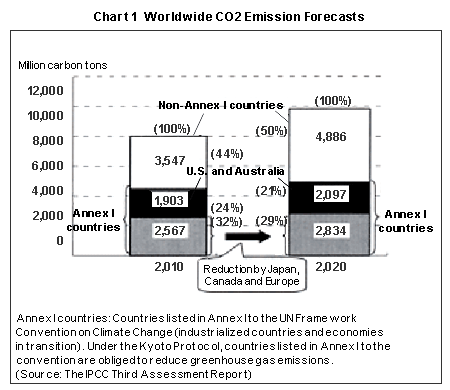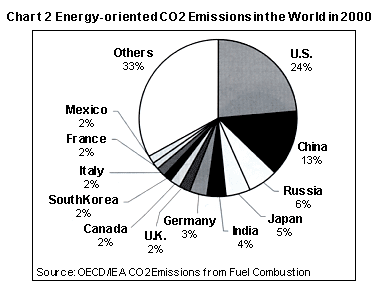Implications of Russia's Ratification of Kyoto Protocol
The World Climate Change Conference convened in Moscow in late September. The conference took place at a time when the Kyoto Protocol, adopted at the Third Conference of Parties to the United Nations Framework Convention on Climate Change (COP 3) in 1997, was ready to take effect should Russia ratify it. With the fate of the Kyoto Protocol very much in the hands of Russia, the latest global warming meeting in Moscow attracted international attention. Even before the conference kicked off, however, the office of Russian President Vladimir Putin had made it clear that Moscow had no intention of ratifying the Kyoto Protocol anytime in the near future. Furthermore, Russia has openly said that ratification of the protocol, from Moscow's point of view, is not an environmental issue but an economic issue, blatantly demonstrating just how much importance Russia attaches to the degree of benefits it can obtain from selling its "hot air" emission credits to Japan and European countries in emissions trading under the framework of the Kyoto Protocol. Russia has also expressed intention to use this ratification issue as leverage to win more favorable conditions in its negotiations over accession to the World Trade Organization. President Putin has reportedly gone so far as to venture to "joke" that Russia, being a country with an extremely cold climate, would not be troubled at all with the expected rise in global temperature. Rather, Putin was quoted as saying that the warmer weather would help Russians save money as they would not have to buy a fur coat. But the problems poised by Russia would not simply end once the protocol is brought into force. Ever since the COP3 meeting, when countries across the world negotiated for the adoption of the Kyoto Protocol, Russia has been regarding the whole issue as an economic or diplomatic matter in which it should strive to win the most favorable conditions possible. Indeed, the Kyoto Protocol is nothing but the product of hard-nosed diplomatic bargaining among nations, as exemplified also by the European Union's devotion to persuade other countries into accepting its idea of the "E.U. bubble," a burden-sharing scheme among E.U. member states.
"Hot Air"
The Kyoto Protocol has set binding targets for industrialized countries to reduce their carbon dioxide and other greenhouse gas emissions over the five-year period between 2008 and 2012 as compared to their respective levels of emissions in 1990. In the last-minute deal struck at the COP3 meeting, it was agreed that Japan, the United States and the E.U. should cut their greenhouse gas emissions by 6%, 7% and 8% respectively. The reduction rate for the E.U. is an aggregate target which its member states are to achieve as a whole, and the E.U. is allowed to exercise discretion in allocating burdens internally. The U.S. pulled out of the Kyoto Protocol soon after President George W. Bush took office. Japan, in the meantime, has been proceeding with strenuous efforts, often likened to "squeezing a dry towel for water," to achieve its emission reduction goal. In light of its own plight, Japan finds the situation of Russia quite enviable. In the first place, Russia's reduction target under the protocol is zero percent from the 1990 level. This was decided despite the fact that Russia's actual greenhouse gas emissions at the time were below the 1990 level due to stagnant economic activity in the 1990s. Not only that, Russian delegates negotiated hard and succeeded in winning 33 million carbon "sink" credits - absorption of carbon dioxide from the atmosphere by its vast forests, doubling the earlier discussed figure. Russia has thus come to claim a large pool of surplus emission credits, and it is very much presumed that other countries, especially Japan, will have no other choice but to rely substantially upon emissions trading with Russia in order to achieve their respective reduction targets imposed under the protocol. As such, the situation has emerged where Russia, a country responsible for 6% of energy-oriented CO2 emissions in the world as of 2000, would have to make hardly any substantial effort to reduce greenhouse gas emissions thanks to the lenient zero percent reduction target and abundant sink capacity. At some point, Russia's surplus CO2 emission credits - which would contribute nothing to the abatement of global warming - have come to be known as "hot air" among environmentalists. The hard-line stance that Russia demonstrated in the recent climate change conference in Moscow was nothing but diplomatic bargaining backed up by the aforementioned mechanism of the Kyoto Protocol.
True Picture of Kyoto Protocol
With negotiations over the global warming problem plagued with North-South confrontation from the very outset, the Kyoto Protocol failed to include any mandatory emission reduction targets for developing countries. The U.S. and Australia then withdrew from the protocol. After the withdrawal of the U.S. and Australia, the remaining members of the Annex 1 countries - industrialized countries, including economies in transition, that take on specific emission reduction commitments under the protocol - cover only 35% of worldwide greenhouse gas emissions based on figures in 1990. Far worse, according to projections by the Intergovernmental Panel on Climate Change (IPCC), the ratio of emissions from these industrialized countries against the global total would decrease to 32% in 2010, then to 29% in 2020, while non-Annex 1 countries - those having no obligations under the Kyoto Protocol - would come to account for some 50% of total greenhouse gas emissions by 2020 (Chart 1).
The U.S. alone accounts for 24% of energy-oriented CO2 emissions as of 2000, while China and India, which both have no obligations under the protocol, and Russia, which has zero duty, are responsible for 13%, 4% and 6% respectively. Emissions from these four countries altogether represent roughly half of the world's greenhouse gas emissions. The four countries plus Japan, which is responsible for 5% of total emissions, would constitute the world's five largest greenhouse gas emitters. Thus, the true picture of the Kyoto Protocol is that only Japan, alone among the five major emitter countries, is to take up the burden of reducing its greenhouse gas emissions by 6% as pledged under the protocol (Chart 2).
Steps to Take
Needless to say, the above argument is not meant to justify backpedaling on efforts to abate global warming. It should be taken as a serious and sincere approach toward the problem of global warming, an issue concerning global public goods, by considering different ways to tackle the problem while the protocol is apparently failing to achieve its intended goal. Negotiations for the Kyoto Protocol's second commitment period from 2013 onward are set to begin by the end of 2005. In order to secure the participation of the U.S. and developing countries, thereby elevating the current framework into one that is truly effective and fair, it is necessary to quickly get rid of the ongoing negative desire to uphold the sanctity of the Kyoto Protocol. In doing so, Japan is required to undertake principle-oriented diplomacy that calls for the international community to tackle the climate change problem as a global issue, while at the same time taking up realistic diplomacy to cope with hard-nosed negotiations in which each country bluntly pursues national interests.


